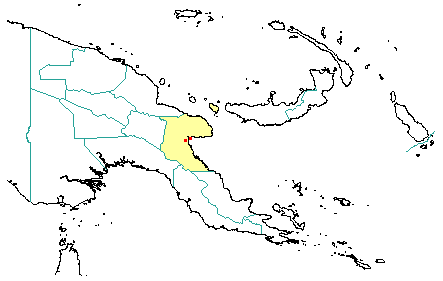
in PNGplants database
PNGTreesKey – Myristica chrysophylla J.Sinclair var. chrysophylla |
Barry Conn (NSW) & Kipiro Damas (LAE).
Guide to trees of Papua New Guinea
Copyright held by the authors, National Herbarium of New South Wales, and Papua New Guinea National Herbarium
Gardens' Bulletin, Singapore Vol. 23: 254 (1968) Fig. 26.
Other Literature: D.B. Foreman, Handbooks of the Flora of Papua New Guinea 187-189 (1978)
Family: Myristicaceae
Dicotyledon
Timber Group: Commercial hardwood
Field Characters: Small sub-canopy tree; Bole cylindrical (up to c. 40 cm diam.); straight (bole up to c. 20 m long); buttresses buttresses absent; spines spines absent; aerial roots aerial roots absent; stilt roots stilt roots absent; Bark grey, brown, or almost black, slightly rough, scaly or flaky or slightly fissured; Subrhytidome (under-bark) dark red; less than 25 mm thick; bark blaze consisting of one layer; faintly to non-aromatic; outer blaze pink or red, markings absent; inner blaze pink or red, markings absent; bark exudate (sap) present, colourless, flowing, colour changing on exposure to air, to orange, brown, or red, sticky; terminal buds not enclosed by leaves.
Indumentum: Complex hairs absent; stinging hairs absent; mature twig indumentum (hairs) present, hairs dense.
Leaves: Leaves clustered at end of branches, spiral (leaves occurring singly at a node and arranged spirally up the branchlet), simple (a leaf composed of a single blade); petiole present, not winged, attached to base of leaf blade, not swollen; leaves equally broad throughout much of length, (10.0-) 16.0-35.0 (-42.0) cm, 5.0-14.0 (-18.0) cm; symmetric, entire, not dissected or lobed, acute or acuminate, venation pinnate, secondary veins open, prominent, intramarginal veins absent; leaves lower surface blue-green, brown, or grey, upper surface green, yellow, or brown (slightly (sometimes), indumentum (hairs) present (lower surface), indumentum (hairs) dense or sparse (hairs pale brown); absent; domatia absent; stipules absent.
Flowers: Inflorescence axillary, flowers arising from a single point or flowers on a branched axis, cones absent; flowers bisexual, stalked, flowers with many planes of symmetry, 7.0-8.0 mm long, diameter small (up to10 mm diam.); perianth present, with all sepals and/or petals (hence tepals) similar, inner perianth pale yellow or brown (pale (caused by presence of brown hairs); 2-3 (-5), some or partly joined or almost all joined; stamens 8-12, absent, joined (to form a central staminal column), free of the perianth; ovary superior, carpels joined (when more than one), locules 1; styles solitary (short, c. 1 mm long), 1.
Fruits: Infrutescence arising from single point or arranged on branched axis, fruit 20.0-23.0 mm long, yellow or brown, not spiny, fleshy, simple, dehiscent, capsule (2-valved); seeds 1, much more than 10 mm long (15-25 mm long), not winged, broad (as wide as long), seed more than 10 mm diam. (c. 20 mm diam.).
Distribution: Morobe.
 | Botanical records in PNGplants database |
Notes: Notes This variety differes from var. entrecasteauxensis by the lower surface of the leaf being, at least in part, covered by persistent hairs, whereas, the latter variety has non-persistent hairs on the leaf such that the lower leaf surface is glabrescent.